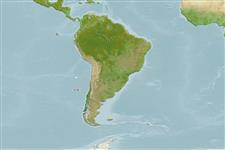Common names from other countries
Environment: milieu / climate zone / depth range / distribution range
Ecología
; rango de profundidad 2 - 200 m (Ref. 4). Subtropical, preferred 18°C (Ref. 107945); 26°S - 34°S, 81°W - 77°W (Ref. 4)
Distribución
Países | Áreas FAO | Ecosistemas | Ocurrencias, apariciones | Introducciones
Southeast Pacific: Juan Fernandez, Chile.
Length at first maturity / Tamaño / Peso / Age
Maturity: Lm ? range ? - ? cm Max length : 48.0 cm BL macho / no sexado; (Ref. 4); 46 cm BL (female)
It has a maximum body length of 48 cm (male) and 46 cm (female); and carapace lengths of 22 cm (male) and 19 cm (female); Reports of total body lengths of 60 to 70 cm have to be considered with much reserve (Ref. 4). Occurs at depths of 2 to 200 m and inhabits a rocky partly sandy environment. Feeds on algae, smaller and larger mollusks, crustaceans and dead animal matter of any kind. There is some migration to deeper waters from the end of September onwards, the species never disappears completely from the coast. In January, the migration back to shallow water starts. Preyed on by various fishes (Ref. 4).
Life cycle and mating behavior
Madurez | Reproducción | Puesta | Huevos | Fecundidad | Larva
Eggs spawned between August and November and carried for about 11 months.
Holthuis, L.B. 1991. (Ref. 4)
IUCN Red List Status (Ref. 130435)
CITES status (Ref. 108899)
Not Evaluated
Not Evaluated
Human uses
Pesquerías: comercial
FAO - pesquerías: landings | FishSource | Sea Around Us
Herramientas
Más información
Age/Size
Crecimiento
Length-weight
Length-length
Morfología
Larva
Abundancia
Fuentes de Internet
Estimates based on models
Vulnerability
Moderate vulnerability (38 of 100).
